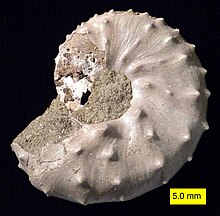
Ammonoids are a group of extinct marine mollusc animals in the subclass Ammonoidea of the class Cephalopoda. These molluscs, commonly referred to as ammonites, are more closely related to living coleoids than they are to shelled nautiloids such as the living Nautilus species. The earliest ammonites appeared during the Devonian, with the last species vanishing during the Cretaceous–Paleogene extinction event.

The nautilus is a pelagic marine mollusc of the cephalopod family Nautilidae. The nautilus is the sole extant family of the superfamily Nautilaceae and of its smaller but near equal suborder, Nautilina.
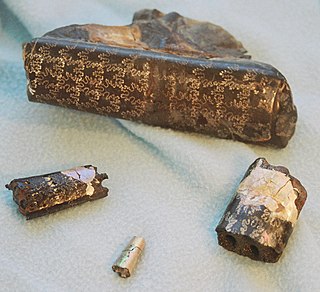
Baculites is an extinct genus of cephalopods with a nearly straight shell, included in the heteromorph ammonites. The genus, which lived worldwide throughout most of the Late Cretaceous, and which briefly survived the K-Pg mass extinction event, was named by Lamarck in 1799.

The Maastrichtian is, in the ICS geologic timescale, the latest age of the Late Cretaceous Epoch or Upper Cretaceous Series, the Cretaceous Period or System, and of the Mesozoic Era or Erathem. It spanned the interval from 72.1 to 66 million years ago. The Maastrichtian was preceded by the Campanian and succeeded by the Danian.
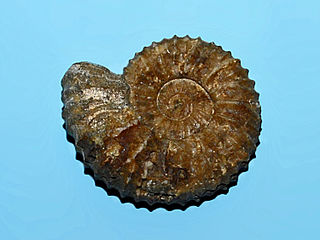
Pavlovia is an extinct genus of ammonite of the Late Jurassic to Late Cretaceous.
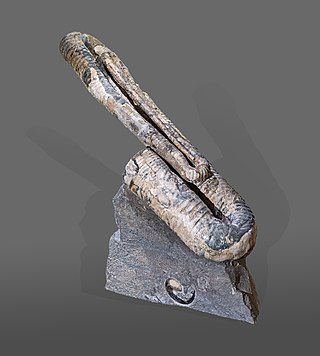
Polyptychoceras is an extinct genus of ammonites from the Late Cretaceous of Asia, Europe, and North and South America. It was first named by Hisakatsu Yabe in 1927.

The Pierre Shale is a geologic formation or series in the Upper Cretaceous which occurs east of the Rocky Mountains in the Great Plains, from Pembina Valley in Canada to New Mexico.
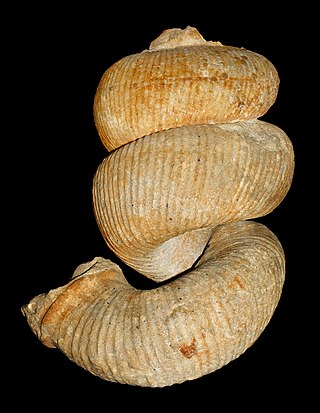
Bostrychoceras is a genus of heteromorph ammonite from the family Nostoceratidae. Fossils have been found in Late Cretaceous sediments in Europe and North America.

Hoploscaphites is an extinct ammonite genus from the Upper Cretaceous and the Lower Paleocene, included in the family Scaphitidae.

Jeletzkytes is an extinct genus of scaphatoid ammonite from the Upper Cretaceous (Maastrichtian) of North America named and described by Riccardi, 1983. In overall form Jeletzkytes closely resembles the genus Scaphites.

Sphenodiscus is an extinct genus of acanthoceratacean ammonite. The genus has been found from many continents and is thought to have had a large global distribution during the Maastrichtian stage of the Late Cretaceous. It was one of the last ammonoids to have evolved before the entire subclass became extinct during the Paleocene, which was directly after the Cretaceous–Paleogene extinction event.

Eutrephoceras is an extinct genus of nautilus from the Late Jurassic to the Miocene. They are characterized by a highly rounded involute shell with slightly sinuous suture patterns.

Phyllopachyceras is an extinct genus of ammonoid cephalopods belonging to the family Phylloceratidae. These nektonic carnivores lived in the Cretaceous, from Hauterivian to Maastrichtian to age.

The Cretaceous–Paleogene (K–Pg) extinction event, also known as the Cretaceous–Tertiary(K–T)extinction, was a sudden mass extinction of three-quarters of the plant and animal species on Earth, approximately 66 million years ago. The event caused the extinction of all non-avian dinosaurs. Most other tetrapods weighing more than 25 kilograms also became extinct, with the exception of some ectothermic species such as sea turtles and crocodilians. It marked the end of the Cretaceous Period, and with it the Mesozoic era, while heralding the beginning of the Cenozoic era, which continues to this day.
This list, 2018 in paleomalacology, is a list of new taxa of ammonites and other fossil cephalopods, as well as fossil gastropods, bivalves and other molluscs that are scheduled to be described during the year 2018, as well as other significant discoveries and events related to molluscan paleontology that are scheduled to occur in the year 2018.
This list 2019 in paleomalacology is a list of new taxa of ammonites and other fossil cephalopods, as well as fossil gastropods, bivalves and other molluscs that are scheduled to be described during the year 2019, as well as other significant discoveries and events related to molluscan paleontology that are scheduled to occur in the year 2019.

The term Paleocene ammonites describes families or genera of Ammonoidea that may have survived the Cretaceous–Paleogene extinction event, which occurred 66.043 million years ago. Although almost all evidence indicated that ammonites did not survive past the K–Pg boundary, there is some scattered evidence that some ammonites lived for a short period of time during the Paleocene epoch, although none survived the Danian ; they were likely extinct within 500,000 years of the K-Pg extinction event, which correlates to roughly 65.5 Ma. The evidence for Paleocene ammonoids is rare and remains controversial.

Eubaculites is an extinct genus of cephalopods in the family Baculitidae and each known species was initially placed within the related genus Baculites until it was placed in a separate genus in 1926.

The Rødvig Formation is a geological formation deposited during the earliest part of the Danian and it was first identified by Richard Taylor and Richard Phillips in 1827. It is known from exposures at Stevns Klint in Denmark. The unit lies directly above the K–Pg boundary and contains fossils that provide a record of the recovery of various groups following the Cretaceous–Paleogene extinction. The upper boundary of the formation is an unconformity in the form of a hardground, beneath which the formation is sometimes missing. The base of the unit is irregular due to the presence of mounding associated with bryozoa, causing variations in thickness. The unit is subdivided into the lower Fiskeler Member mainly formed of marl and the overlying Cerithium Limestone Member.
